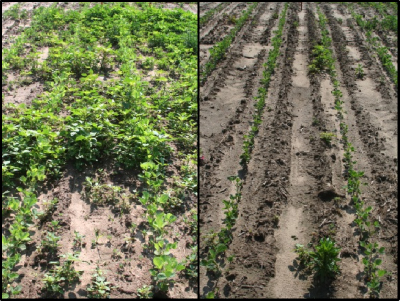USDA-NIFA Extension IPM Grant
Pest & Crop Newsletter, Entomology Extension, Purdue University
- Stunted, Burned, and Crinkled Soybean Plants
- VIDEO: Soybean Seedling, Sampling and Submission for Problem Diagnosis
Stunted, Burned, and Crinkled Soybean Plants – (Travis Legleiter and Bill Johnson) -
Approximatly 14% of the state’s soybeans were planted during the week of May 4th-10th when soil and weather conditions were ideal for planting. The cold, wet weather that followed was not ideal for soybean emergence, and we have received a number of samples into the clinic that were treated with a preemergence group 14 (PPO-inhibiting herbicide).
The group 14 class of herbicides create oxygen radicles at toxic levels that destroy the lipids of cell membranes and create the necrotic spotting and burning that most of us recognize as leaf burning and blazing. These herbicides can be applied to soybean plants because of their ability to rapidly metabolize the herbicide and reduce the levels of toxic radicles when soybeans are actively growing. However, under stressful growing conditions, such as cold, wet weather,, soybean plants are unable to metabolize these herbicides as quickly leading to injurious levels of oxygen radicles.
Wet soil conditions and frequent rain events following soybean planting were ideal for soybean injury by soil applied group 14 herbicides. The sustained cool, wet, soil conditions that soybean plants emerged in were less than ideal for rapid herbicide metabolism and thus lead to injury to some fields receiving one of these herbicides. Soybean injury was also increased due to heavy rainfall events that splashed herbicides on the soil surface onto emerging soybean hypocotyls, cotyledon, and/or leaves depending on the soybean growth stage. Injury symptoms include crinkled leaves, necrosis of the hypocotyl and cotyledons, and necrotic spotting on leaves where the herbicide has been splashed during a rainfall event.
Very poor emergence patterns
Struggling to emerge soybean
Typically the risk of injury is higher in sandy and coarse soils, although this year it seems as if all soils were affected due to the cool, wet weather conditions.
In the majority of cases soybean plants are able to grow out of the initial injury and stunting and yield losses should not occur. Only in rare cases of severe injury to the hypocotyl and/or growing point will replanting be required. Fields should be considerd for replanting if significant stand losses occur from the combined herbicide, cold injury, drowning, seedling diseases, or any combination of these four factors that has occured. If you suspect injury from flumioxazin, sulfentrazone, or saflufenacil, or seedling diseases on soybean you can send a sample to Purdue Plant and Pest Diagnostic lab <http://www.ppdl.purdue.edu/PPDL/> for further confirmation.
The increased amount of injury to soybean this year may cause some of our producers to avoid soil-applied herbicides in the future. We have seen exceptional weed control out of these group 14, PPO-inhibiting herbicides at our Palmer amaranth research site last season, especially with flumioxazin which seems to be causing the majority of soybean injury in the state. So producers need to weigh this risk of temporary injury against quality control of problematic weeds such as Palmer amaranth, common waterhemp, and marestail. In the majority of years these products pose little threat of soybean injury and sustain their level of weed control.
Image 1. The top photos are of a plot not receiving a preemerge
herbicide and on the right a plot receiving a preemerge
application containing flumioxazin. Notice the
stunting injury of soybeans by the flumioxazin as well as
the reduced population of Palmer amaranth that will be
much more manageable as compared to the untreated plot.
VIDEO: Soybean Seedling, Sampling and
Submission for Problem Diagnosis





